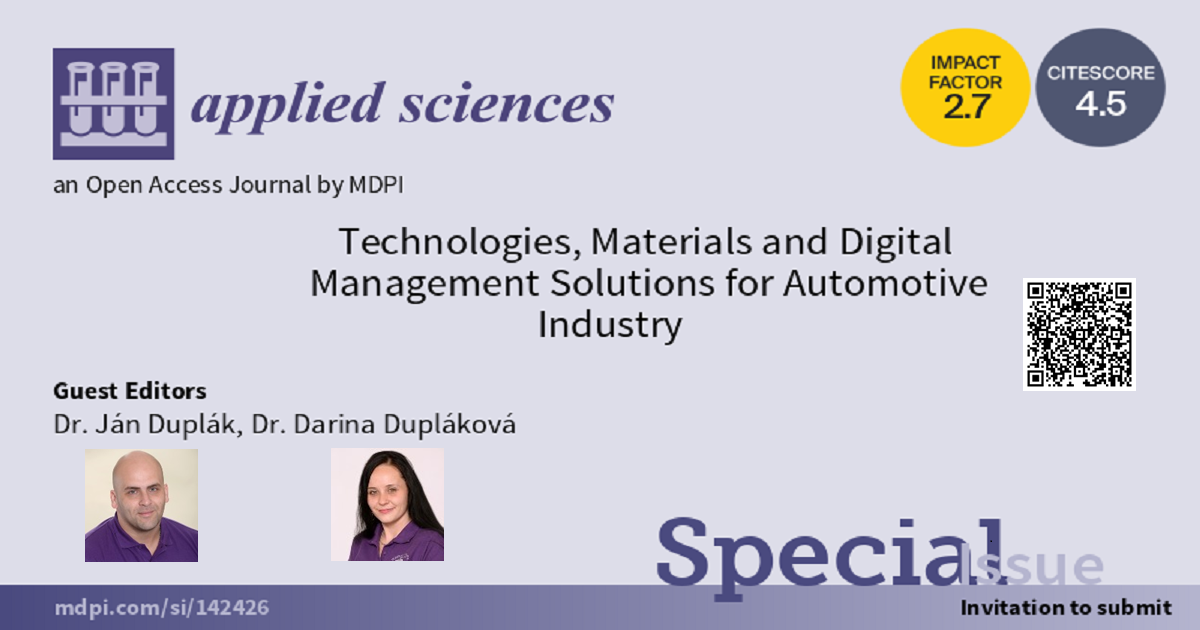- 2.5Impact Factor
- 5.5CiteScore
- 20 daysTime to First Decision
Technologies, Materials and Digital Management Solutions for Automotive Industry
This special issue belongs to the section “Applied Industrial Technologies“.
Special Issue Information
Dear Colleagues,
We are inviting submissions for this Special Issue, “Technologies, Materials and Digital Management Solutions for the Automotive Industry”.
The automotive industry can be considered as a key industry sector in the worldwide context, and is one of the main pillars of the global economy. The automotive industry should not be considered as a sector solely intended for the production of vehicles, but also as a sector for the manufacture of partial modules, systems and components. Based on the demand for individual components, the automotive industry can be considered as a significant contributor to the engineering, electrotechnical and chemical industries. In the interest of developing the automotive industry so that it is equipped with modern production and control methods, further research is required. The complex synergy of technologies, materials and management utilizing the digital solutions provided by Industry 4.0 necessitates strong leadership to monitor and drive continual progress in the automotive industry. This Special Issue is dedicated to this progress, with a primary focus on scientific knowledge and transfer into the research and development of technologies, materials, management and digital solutions for the automotive industry.
Dr. Ján Duplák
Dr. Darina Dupláková
Guest Editors
Manuscript Submission Information
Manuscripts should be submitted online at www.mdpi.com by registering and logging in to this website. Once you are registered, click here to go to the submission form. Manuscripts can be submitted until the deadline. All submissions that pass pre-check are peer-reviewed. Accepted papers will be published continuously in the journal (as soon as accepted) and will be listed together on the special issue website. Research articles, review articles as well as short communications are invited. For planned papers, a title and short abstract (about 250 words) can be sent to the Editorial Office for assessment.
Submitted manuscripts should not have been published previously, nor be under consideration for publication elsewhere (except conference proceedings papers). All manuscripts are thoroughly refereed through a single-blind peer-review process. A guide for authors and other relevant information for submission of manuscripts is available on the Instructions for Authors page. Applied Sciences is an international peer-reviewed open access semimonthly journal published by MDPI.
Please visit the Instructions for Authors page before submitting a manuscript. The Article Processing Charge (APC) for publication in this open access journal is 2400 CHF (Swiss Francs). Submitted papers should be well formatted and use good English. Authors may use MDPI's English editing service prior to publication or during author revisions.
Keywords
- conventional manufacturing technologies
- advanced manufacturing technologies
- smart manufacturing technologies
- manufacturing processes and logistics
- assembly
- maintenance
- automation
- optimization and rationalization
- sustainability
- Industry 4.0
- software solutions
- simulation and modelling
- digital ergonomic solutions
- occupational safety
- risk management

Benefits of Publishing in a Special Issue
- Ease of navigation: Grouping papers by topic helps scholars navigate broad scope journals more efficiently.
- Greater discoverability: Special Issues support the reach and impact of scientific research. Articles in Special Issues are more discoverable and cited more frequently.
- Expansion of research network: Special Issues facilitate connections among authors, fostering scientific collaborations.
- External promotion: Articles in Special Issues are often promoted through the journal's social media, increasing their visibility.
- e-Book format: Special Issues with more than 10 articles can be published as dedicated e-books, ensuring wide and rapid dissemination.

